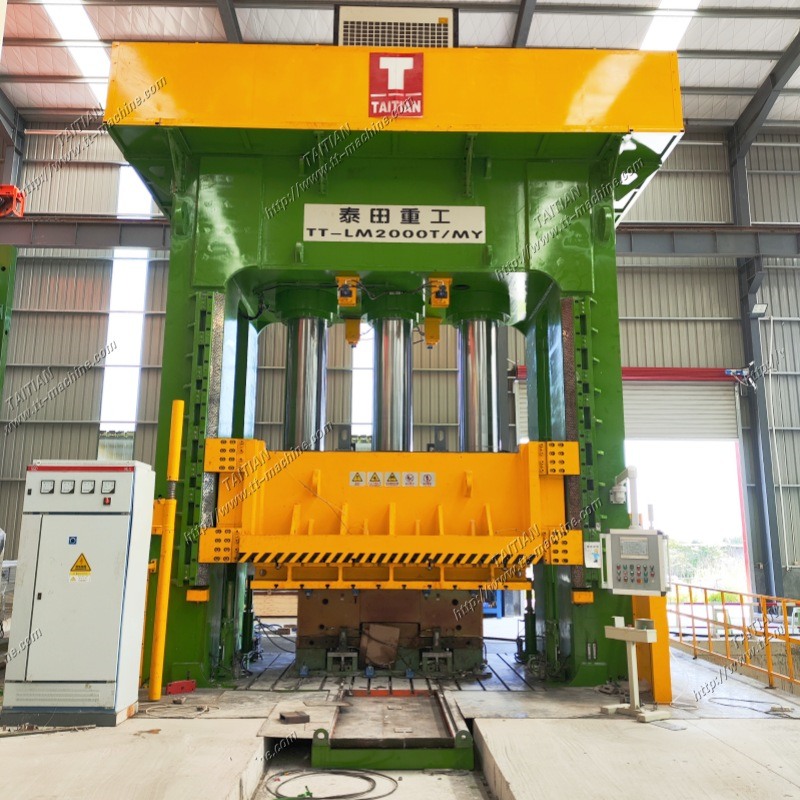What Is a Composites Hydraulic Press and How Does It Transform Manufacturing?
2025-01-07
In the world of modern manufacturing, particularly in industries like aerospace, automotive, and construction, the demand for advanced materials is ever-growing. Composites, which combine different materials to create superior properties, have become a popular choice due to their strength, light weight, and versatility. However, creating these materials often requires specialized equipment to achieve the necessary precision and performance. This is where composites hydraulic presses come into play.
But what exactly is a composites hydraulic press, and why is it so crucial in transforming manufacturing processes? In this blog, we’ll explore the importance of hydraulic presses in composites manufacturing, how they work, and why they are indispensable in creating high-performance materials.
What Is a Composites Hydraulic Press?
A composites hydraulic press is a specialized machine used to shape and cure composite materials under high pressure and temperature. The press applies consistent pressure to the composite materials, typically layers of fibers and resin, which are then molded into specific shapes. The process often involves heat and pressure, both of which are crucial to ensure that the resin properly bonds with the fibers and the material achieves the desired strength, durability, and other properties.
The hydraulic press uses hydraulic force, meaning that the pressure is applied through the use of a fluid (usually oil) that is controlled by pumps and valves. This fluid-based system is ideal for creating the precise and uniform pressure required to process composites without risk of damage to the material.
How Does a Composites Hydraulic Press Work?
The operation of a composites hydraulic press can be broken down into several key stages:
1. Material Loading:
The first step involves loading the composite material, which could be in the form of pre-preg (pre-impregnated with resin), woven fabric, or chopped fiber mat, into the mold or press cavity. The composite materials are typically stacked in layers, with resin applied between them.
2. Heating the Mold:
Before pressure is applied, the mold is often preheated. The temperature helps the resin become more fluid, ensuring that it can bond properly with the fibers and cure efficiently during the pressing process. The press’s heating system may include electric heating elements or circulating heated fluid.
3. Applying Pressure:
The hydraulic press applies significant force, often measured in tons, to compress the composite material. The pressure ensures that the fibers and resin form a solid bond, removing any air bubbles or voids in the material. The consistency of pressure is critical during this step to ensure uniform thickness and density.
4. Curing the Material:
In many cases, the material is subjected to both heat and pressure during the curing phase. The resin used in composites typically cures or hardens when exposed to heat, and the pressure helps mold the material into the desired shape. The press may maintain constant pressure for a set period to allow the material to cure completely.
5. Cooling and Ejection:
Once the composite material has cured, it is allowed to cool. The hydraulic press will then retract, allowing the formed composite part to be removed from the mold. The final product is typically a lightweight, durable part ready for use in manufacturing.
Why Are Composites Hydraulic Presses Essential?
Composites hydraulic presses are essential in a variety of industries due to the unique benefits they offer in terms of material processing and part production. Here are a few reasons why they are so critical:
1. High-Pressure and Heat Control:
The combination of high pressure and controlled heating is vital for ensuring the quality and consistency of composite materials. These materials often require specific temperatures and pressures to achieve the right mechanical properties. Hydraulic presses offer precise control over both factors, ensuring that each part is manufactured to specification.
2. Precision and Consistency:
A hydraulic press applies uniform pressure across the material, which is crucial for creating high-quality composite parts. Even a slight variation in pressure could lead to defects like air pockets or uneven resin distribution, which would compromise the performance of the final product. Consistency is key in industries like aerospace, where even the smallest defect can have significant consequences.
3. Large-Scale Production:
Hydraulic presses are capable of handling large volumes of material in a single press cycle, which is essential for industries with high production demands. Whether it’s producing large composite panels for an airplane wing or automotive body parts, hydraulic presses allow for efficient and rapid mass production.
4. Complex Geometries:
Composites often need to be molded into intricate shapes, and hydraulic presses excel in this area. The ability to apply uniform pressure across complex molds makes hydraulic presses ideal for producing parts with complex geometries, which would be difficult to achieve using other manufacturing methods.
5. Versatility:
Composites hydraulic presses are used for a wide range of applications. From the aerospace industry to automotive manufacturing, these presses are designed to process a variety of composite materials, such as carbon fiber, fiberglass, and natural fibers. The ability to work with different types of composites adds versatility to the manufacturing process.
Types of Composites Hydraulic Presses
There are several different types of hydraulic presses used in composites manufacturing, each designed for specific applications:
1. C-Frame Hydraulic Press:
C-frame presses have a C-shaped frame that allows for easier material loading and unloading. These presses are commonly used for smaller to medium-sized parts and are known for their efficiency and ease of use.
2. Four-Post Hydraulic Press:
A four-post hydraulic press features four vertical posts to support the press bed and provide greater stability during pressing. These presses are used for larger composite parts, especially those that require uniform pressure distribution over a wide surface area.
3. Transfer Molding Press:
Transfer molding presses are used to inject composite materials into a mold cavity under high pressure. They are often used in applications where precision and uniformity are critical, such as in the production of high-performance automotive or aerospace components.
4. Hot Pressing Press:
Hot pressing presses combine heat and pressure to cure composite materials. These presses are ideal for materials that require both heating and compression during the curing process, such as thermosetting resins in carbon fiber composites.
5. Hydraulic Laminating Press:
Laminating presses are used to create multi-layer composite parts by applying heat and pressure to each layer individually. This is common in the production of composite panels or sheets, especially in industries like construction or shipbuilding.
Common Applications of Composites Hydraulic Presses
Composites hydraulic presses are used in a variety of industries to produce high-performance components. Some of the most common applications include:
1. Aerospace:
In aerospace manufacturing, composite materials are widely used to reduce the weight of aircraft while maintaining strength and durability. Hydraulic presses are used to produce parts such as wings, fuselage sections, and interior components.
2. Automotive:
The automotive industry uses composite materials to make lightweight and fuel-efficient vehicles. Hydraulic presses are used to produce parts like body panels, bumpers, and chassis components, all of which benefit from the strength and light weight of composites.
3. Construction:
Composites hydraulic presses are used in the production of durable composite panels, which are used in construction materials, insulation, and other applications requiring strong, weather-resistant materials.
4. Sports Equipment:
High-performance sports equipment, such as bicycles, skis, and tennis rackets, often relies on composite materials to improve strength while keeping weight low. Hydraulic presses are used to mold and cure the materials into precise shapes.
5. Marine:
The marine industry uses composites for boat hulls, decks, and other parts, as they provide resistance to corrosion while maintaining strength and buoyancy. Hydraulic presses help form these parts into complex shapes and sizes.
Conclusion: The Future of Composites Hydraulic Presses
Composites hydraulic presses are an indispensable part of modern manufacturing, allowing for the creation of high-performance materials and components that are crucial in industries ranging from aerospace to automotive. The ability to precisely control pressure and temperature, combined with the versatility to work with a wide variety of materials, makes hydraulic presses a key tool in producing the next generation of composite parts.
As the demand for lightweight, durable, and high-performance materials continues to grow, the role of composites hydraulic presses will only become more vital. With advancements in press technology and material science, these machines will continue to shape the future of manufacturing, enabling the production of innovative products that meet the needs of today and tomorrow.



